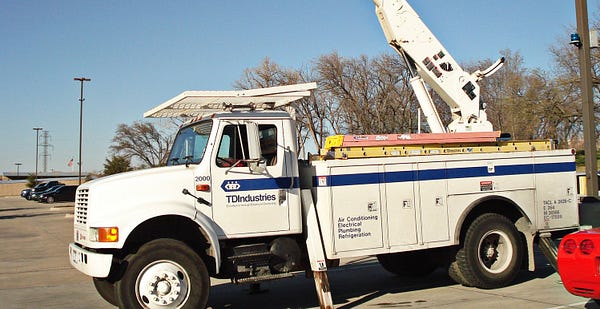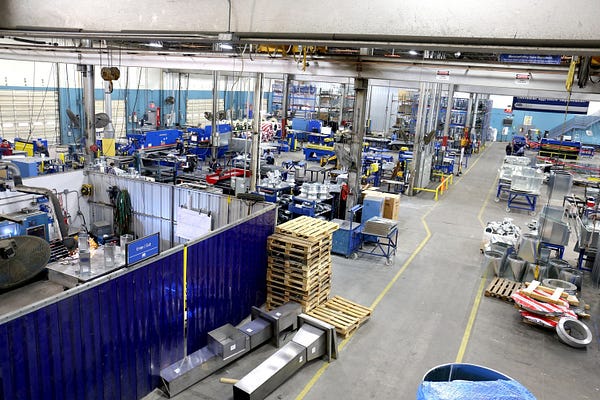An Organizational Culture that Drives Success
by John Case
This story was originally published at Employee-Owned America, February 1, 2019, and is reposted here with permission.

What’s interesting about TDIndustries, a big mechanical construction and facilities-services firm, isn’t just its business results, though heaven knows those results are impressive enough. Founded 73 years ago in Dallas, TD has expanded across Texas and now has operations in Arizona and Colorado as well. Its payroll has grown to 2,500, its revenue to $630 million. Its projects include such Dallas landmarks as the American Airlines Center and the still-under-construction Globe Life Field, the Texas Rangers’ new 2020 home. Plans are on the drawing board for further expansion — and for more big projects.
Even more interesting than the performance itself is TD’s business model, which explains how the company delivers its remarkable results.
The company doesn’t reveal its earnings, but they are no doubt healthy. The stock price rose 18 percent in 2015, 19 percent in 2016, and 25 percent in 2017. TD’s employees — Partners, as the company calls them — own all the shares through an employee stock ownership plan, or ESOP. Even more interesting than the performance itself is TD’s business model, which explains how the company delivers its remarkable results.

“In the construction industry,” says Hattie Peterson, senior vice-president of marketing, “a specialty contractor can be looked at as a commodity. Who can do it the fastest, who has the lowest bid.” At TD, she continues, “we recognize that price is always a factor, but it’s more important for us to build relationships with our clients. We want to be known as the trusted partner of the general contractor and the building owners we serve — and not just for the project, but for the building’s lifecycle.” To that end TD offers construction, maintenance services, facilities management, and special-projects work such as renovation or expansion.
Think for a moment about the challenge that model presents. A company doesn’t get to become a trusted partner just by saying so. It has to provide top-quality work. It has to have highly skilled, utterly reliable people on every jobsite and in every function — engineering, fabrication, and so on. It must attract and retain all those people and ensure that they upgrade their skills over time. It must ensure that everyone on the payroll understands the importance of going the extra mile for customers and for each other.
Unless it can meet those challenges, the business model breaks down. So let’s look at how TDIndustries keeps the model humming.
Employee ownership. Unlike a lot of employee-owned companies, TD asks people to buy in to the ESOP through payroll deductions. About 80 percent have done so. Every year, the company contributes 15 percent of its profits into ESOP accounts and another 15 percent to 401(k) accounts. (The contributions have amounted to about 65 cents per employee dollar in recent years.) So people who stay with the company can expect to build up a comfortable nest egg. “Employee ownership is huge,” says HR director Tara Albertson. “It’s definitely a recruiting and retention tool.” Employees are Partners from day one. They are eligible to participate in the ESOP after 30 days.
“Employee ownership is huge,” says HR director Tara Albertson. “It’s definitely a recruiting and retention tool.”
Employee ownership has another advantage as well: the company can invest heavily in its people because there are no absentee owners clamoring for dividends. “TD is free to make decisions that serve our customers and empower our employees,” says Bob Wilken, a 25-year TD veteran whose title is president of select markets and acquisitions — “as opposed to the next earnings call with outside investors.”
Training. If you’re an apprentice plumber and you want to become a journeyman and eventually a master plumber, TD will pay for the appropriate night-school courses. If you’re an engineer looking for a master’s or a doctorate in a relevant field, TD will pay for that, too, so long as it makes good business sense. The company provides many of its employees with “learning maps” showing the steps they need to take to boost their skills and thereby increase their pay.
This emphasis on education seems to pervade the place. “We have our core classes, developed in house,” says HR’s Albertson. “They’re about our culture. There are five or six classes that every Partner will take.” (We’ll get to TD’s memorable culture in a moment.) The company also runs a leadership development program, hires specialized firms to teach trade classes on site, and offers a “Learning in the Morning” program, open to any Partner, that explicates a TD process. We could go on, but you get the idea.

Best practices. The company operates a 6,000-square-foot facility in nearby Richardson for the higher-purity construction required by clients such as pharmaceutical or semiconductor companies. But its main fabrication shop is an 85,000-square-foot facility located at its Dallas headquarters and staffed by 90 Partners over two shifts.
The Dallas shop is where TD bends and shapes sheet metal into ductwork, builds the complex plumbing fixtures required for large-scale buildings such as a stadium, and does all the necessary welding. Some years ago the shop plunged into the tools and techniques of Lean, and the evidence is everywhere. A tour led by production manufacturing manager Jason Hogan reveals clean and uncluttered work areas, minimal inventories, and well-organized workflows. Charts on a bulletin board track things like manufacturing overhead expenses and savings from process changes. Employees are recognized for continuous-improvement suggestions. Rogelio Aguilar, for example, created a rotary table in the assembly area to hold different size dampers so he and his coworkers wouldn’t have to fetch each one from the warehouse. Estimated savings: upwards of $3,000 a year.
The TDIndustries Culture
This item gets the big heading because there are so many different elements that contribute to it. For instance:
- Servant Leadership. TD founder Jack Lowe Sr. discovered Robert Greenleaf’s well-known management philosophy in the early 1970s. After discussing it with other company leaders for a couple of years, he introduced it to TD, and the company has practiced it ever since. Leaders learn the principles in classes. They learn to ask rather than tell. They learn that “it’s about caring for the person, building the person, the Partner, versus climbing your way up the ladder,” as Hattie Peterson puts it. She adds: “The only way you grow at TD is by growing others around you.”
Five “core values” — relating to safety, excellence, trust, servant leadership, and “the power of individual differences” — appear on the back of everyone’s business card. They’re illustrated on wall-size posters at headquarters.
- Core values. A lot of companies trumpet their values; TD seems to take them more seriously than most. Five “core values” — relating to safety, excellence, trust, servant leadership, and “the power of individual differences” — appear on the back of everyone’s business card. They’re illustrated on wall-size posters at headquarters. “The first class you take at TD is ‘Catch the Spirit,’” says Peterson. “That’s where our Partners learn about our servant leadership culture and dive into the meaning of our core values. So every Partner knows them. They’re repeated in our huddles. Even our individual performance reviews are based around living the core values.”
- Intensive reviews. Those reviews take place four times a year, for every partner. They might last an hour or more, with only the first few minutes devoted to an assessment of past performance. From then on it’s a conversation about the Partner’s goals and plans. “With young people, I urge them to go to school,” says Bill Avalos, manufacturing production manager. “It’s the best way they’re going to get a pay raise.” Employees also review their managers, once a year, anonymously.
- Communication and transparency. TD runs Catch the Spirit training not only for every new employee but for employees of companies that TD acquires. It operates an intranet called the Pipeline that lets everyone see the state of the company — jobs under way, financial performance, and so on. Another intranet is called TDWiki. “That’s where all the documents are housed to help you do your job,” says Dennis Washington, a production specialist who helped design and develop the system. “The forms, the instructional stuff, like that.”
- Symbols. Walk into any TD facility and the first thing that hits you are the walls filled with photographs of employees. Every Partner with at least five years of service appears on those walls. Other walls show the core values and the mission statement, along with inspirational messages (“We have a diverse, people-centered culture built on a foundation of trust.”) Oh, yes: the org chart is printed the reverse of the usual way, with CEO Harold MacDowell at the bottom — serving those above him, so to speak. In 2017, MacDowell was #7 on Inc. magazine’s list of the world’s top 10 servant leaders. Symbols, like words, matter.
- Fun. “TD can party!” says HR director Albertson. “We like to have a good time.” There’s the big enterprise-wide TD Barbecue, a celebration for Halloween, another for Flag Day. MacDowell dresses for the occasion: Uncle Sam on Flag Day, a leprechaun on St. Patrick’s Day. Last year, that was when he announced the new stock price — the “pot of gold.”
Fortune has named TDIndustries one of its 100 Best Companies to Work For “Legends” — the company has made the magazine’s famous list for 21 consecutive years. If TD’s business strategy and its future depend on its people, it seems to be doing a lot of things right.
What about that future? The company gets frequent buyout offers, MacDowell told Contracting Business in 2015. But it isn’t for sale. “If we sold out to somebody else, they’d want to run the number up, flip it, and take it public. And I haven’t seen many of those operations preserve the cultures of the great companies that were bought out.
“We’re focused on generating the wealth through the ESOP,” he concluded, “without killing the culture.”
John Case is the editor of Employee-Owned America. He is a veteran journalist, a former senior writer at Inc. magazine, and author or coauthor of numerous books on business and economics. With Corey Rosen and Martin Staubus, he wrote the pathbreaking book Equity: Why Employee Ownership Is Good for Business, published by Harvard Business School Press.
Fifty by Fifty is working to transform the U.S. economy by growing employee ownership. Join our campaign, and we’ll send our monthly newsletter, filled with great company stories, right to your in box.
